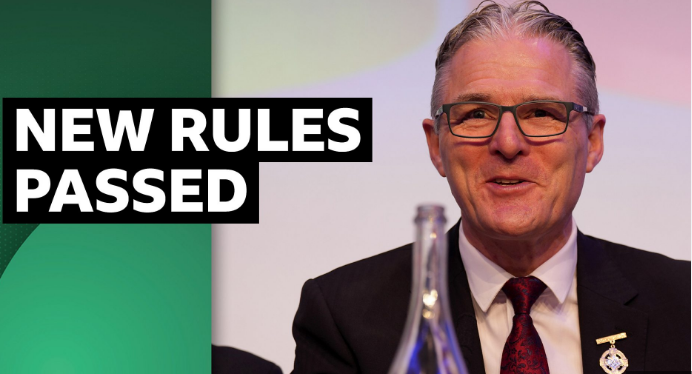Introduction to the New Gaelic Football Rules
The Gaelic Athletic Association (GAA) has recently introduced a series of changes to the existing Gaelic football rules, aiming to enhance the overall quality of the game. These revisions stem from ongoing discussions among stakeholders, including players, coaches, and officials, who have sought to address the evolving dynamics of modern Gaelic football. The key motivations behind these amendments include the pursuit of a more fluid style of play, the need for greater clarity in officiating, and the desire to ensure that matches are both engaging and equitable for all participants.
Among the notable modifications is the adjustment of specific regulations responsible for promoting free-flowing gameplay. The adoption of new rules is intended to minimize interruptions caused by fouls, thereby allowing for a more continuous playing experience that can entertain fans and participants alike. This shift is anticipated to foster a more dynamic atmosphere on the field, compelling teams to adopt a more strategic and engaging approach to their play styles.
The recently revised rules also focus on player safety and sportsmanship, which are critical components of the GAA’s ethos. By refining the existing regulations, the organization aims to decrease the risk of injuries without sacrificing the physicality that characterizes Gaelic football. Notably, these changes have garnered praise from prominent figures within the sports community, including former Dublin manager Jim Gavin and current GAA President Jarlath Burns, who emphasize the importance of these rules in nurturing a competitive yet fair sporting environment.
The implications of these changes extend beyond the immediate effects seen on the pitch. By prioritizing a set of rules that enhances gameplay while maintaining player welfare, the GAA is taking significant steps to adapt to the nuances of contemporary Gaelic football, ensuring that the sport remains relevant, exciting, and true to its heritage.
GAA President’s Perspective
Jarlath Burns, the GAA President, has recently expressed strong support for the newly introduced rules governing Gaelic football. He envisions these adjustments not merely as regulatory changes but as a vital enhancement aimed at preserving the integrity of the sport. According to him, these new rules are designed to foster a more dynamic and engaging brand of Gaelic football, ultimately elevating the game in the eyes of both players and spectators.
Burns emphasizes the positive implications these changes are likely to have on player welfare. By introducing reforms that prioritize safety and fair play, the GAA is taking a significant step toward ensuring that athletes can perform at their best without the undue risk of injury. The new guidelines align closely with the GAA’s mission to promote Gaelic games while safeguarding the interests and health of participants. He believes that these rules will offer players a more enjoyable and less hazardous experience on the pitch.
From a spectator perspective, Burns is optimistic about the engaging nature of the forthcoming season. He suggests that by making the game more fluid and exciting, fan interest in Gaelic football will escalate. He noted how an enhanced viewing experience can lead to increased attendance at matches, as well as a broader television audience. Jim Gavin, a renowned coach within the sport, supports this outlook and highlights the significance of adapting the rules to mirror the evolving expectations of modern athletics.
In conclusion, the GAA President’s insights delineate a roadmap for the future of Gaelic football, emphasizing player safety and spectator engagement. The newly introduced rules are positioned not just as amendments but as strategic moves that underscore the GAA’s commitment to fostering a vibrant and sustainable sporting culture.
Comparative Analysis with Serie A Football
The evolution of sports often necessitates regulatory adaptations to ensure that the game remains exciting, safe, and fair for all participants. In recent years, both Gaelic football and Serie A have introduced pivotal rule changes aimed at enhancing the overall gameplay experience. These modifications reflect the sports’ commitment to player safety and spectator enjoyment. The newly instituted Gaelic football rules, praised by GAA President Jarlath Burns, can be juxtaposed with Serie A regulations to illustrate how both sports respond to the evolving dynamics of athletic competition.
One notable parallel is the emphasis on player safety. In Gaelic football, new rules, such as stricter regulations on high tackles, mirror those in Serie A, where similar initiatives have been implemented to reduce head injuries and ensure athlete welfare. The Italian league has made efforts to penalize dangerous play and improve the quality of officiating, culminating in a safer environment for its players. Both sports share an overarching goal of protecting those who participate, reinforcing their core value that the well-being of athletes comes first.
While the adaptations in Gaelic football primarily emphasize maintaining the game’s traditional essence, Serie A has undergone several modifications to foster a more dynamic pace of play. The introduction of video assistant referees (VAR) in Serie A has transformed decision-making processes, enhancing transparency and fairness in officiating. Similarly, the GAA has recognized the need for immediate and accurate adjudication regarding rules, emphasizing the importance of technology in modern sports. Both leagues continue to face challenges in implementing these changes effectively, as resistance from traditionalists has been evident in both Gaelic football and Serie A.
In conclusion, the regulatory changes in Gaelic football and Serie A reveal a shared commitment to improving player safety and enhancing viewer engagement. By learning from one another’s experiences, these sports can foster a competitive yet secure environment that appeals to fans and supports the athletes’ longevity in their respective fields.
The Future of Gaelic Football: Expectations and Goals
The landscape of Gaelic football is set to undergo significant transformation following the recent implementation of new rules designed to enhance the game. These changes are anticipated to influence various facets of the sport, from player training regimens to fan engagement strategies. With this evolution, there is an optimistic outlook from GAA President Jarlath Burns, who envisions a rejuvenated spirit in Gaelic football as it embarks on this new chapter.
One of the primary expectations is that the new rules will lead to a shift in how players prepare for matches. With a focus on skill development and tactical awareness, coaches are likely to adjust their training methodologies. This could mean a greater emphasis on agility, quick decision-making, and an overall more dynamic style of play, aligning Gaelic football more closely with the demands seen in other popular sports, including soccer, and perhaps drawing parallels with the structure of Serie A. Enhanced practice environments that incorporate technology and analytics may also play a pivotal role in preparing players for competitive settings.
Moreover, as the rules evolve, the relationship between the sport and its supporters is expected to deepen. Engaging fans through interactive campaigns and educational initiatives could foster an appreciation of the nuances introduced by the new regulations. This effort may bridge gaps between traditionalists and newer audiences, broadening the appeal of Gaelic football and positioning it in the wider sporting conversation—similar to the fervor surrounding figures like Jim Gavin in the broader GAA landscape.
Ultimately, the future of Gaelic football rests on these updates, heralding a transformative period that holds potential for growth, engagement, and enhanced athletic performance. As Jarlath Burns emphasizes, these adaptations lay the groundwork for a prosperous future in the GAA community.

